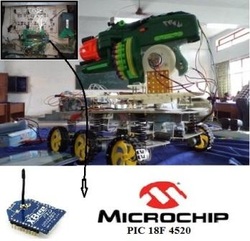Project 2

TITLE: MULTI TERRAIN COMBAT ROBOTIC VEHICLE-2 (version - 2)
Description:
This was my favorite project. I had already built a robot of similar kind(version - 1). So, the mechanical structure remains untouched but the electronics in it have changed a lot and moreover the bot has been programmed(version - 1 is not a programmed bot).
This project is basically an improved version of MTCRV-1, one of my best projects. The improvement is in terms of efficiency, power consumption, flexibility of control and RF range.
Project entitled “MTCRV-2” is a prototype of computer controlled wireless military vehicle(Tele-combat robot). The aim of this model is to provide the troops with a robotic combat platform that can be operated from a place which is far away from the battle field. The gun mounted on the vehicle can be used to aim and even fire at the enemies. Shortly describing, it is a prototype of a remotely operated soldier.
This bot receives the commands from a computer through 2.4 GHz RF link (1 mile range). The bot is equipped with a wireless camera with a laser pointer using which one can aim at targets by sitting in the control room itself. I have mounted a toy gun so that it can fire at the targets. The bot has got some springs(suspension system) in order to travel in different terrains.
As further implementation, I would like to add IoT to this bot so that it can be controlled from any place in the world.
Results:
Am not new to wireless communications when I started this project but am new to ZIGBEE wireless communication protocols. This project provided me with a platform to enhance my knowledge on wireless communication with ZIGBEE protocol. I haven't faced any challenge regarding the physical structure of this bot since I have used the mechanical structure of MTCRV - 1. But the most challenging part is the programming, I have programmed the microcontroller to provide ASYNCHRONOUS COMMUNICATION between the bot and the computer. This is quite challenging because programming a PIC is pretty complex when compared with programming an AVR. Coming to the design of PCB, its a home made PCB etched using TONER TRANSFER technique. Since this PCB is large, it gave a lot of struggle in etching it at home.
References:
Description:
This was my favorite project. I had already built a robot of similar kind(version - 1). So, the mechanical structure remains untouched but the electronics in it have changed a lot and moreover the bot has been programmed(version - 1 is not a programmed bot).
This project is basically an improved version of MTCRV-1, one of my best projects. The improvement is in terms of efficiency, power consumption, flexibility of control and RF range.
Project entitled “MTCRV-2” is a prototype of computer controlled wireless military vehicle(Tele-combat robot). The aim of this model is to provide the troops with a robotic combat platform that can be operated from a place which is far away from the battle field. The gun mounted on the vehicle can be used to aim and even fire at the enemies. Shortly describing, it is a prototype of a remotely operated soldier.
This bot receives the commands from a computer through 2.4 GHz RF link (1 mile range). The bot is equipped with a wireless camera with a laser pointer using which one can aim at targets by sitting in the control room itself. I have mounted a toy gun so that it can fire at the targets. The bot has got some springs(suspension system) in order to travel in different terrains.
As further implementation, I would like to add IoT to this bot so that it can be controlled from any place in the world.
Results:
Am not new to wireless communications when I started this project but am new to ZIGBEE wireless communication protocols. This project provided me with a platform to enhance my knowledge on wireless communication with ZIGBEE protocol. I haven't faced any challenge regarding the physical structure of this bot since I have used the mechanical structure of MTCRV - 1. But the most challenging part is the programming, I have programmed the microcontroller to provide ASYNCHRONOUS COMMUNICATION between the bot and the computer. This is quite challenging because programming a PIC is pretty complex when compared with programming an AVR. Coming to the design of PCB, its a home made PCB etched using TONER TRANSFER technique. Since this PCB is large, it gave a lot of struggle in etching it at home.
References:
- Robot Builders Bonanza - Gordon Mccomb
- Interfacing PIC Microcontrollers Embedded Design by Interactive Simulation; Martin Bates
- Mobile Robots Inspiration to Implementation - Flynn and Jones
Click here for videos

